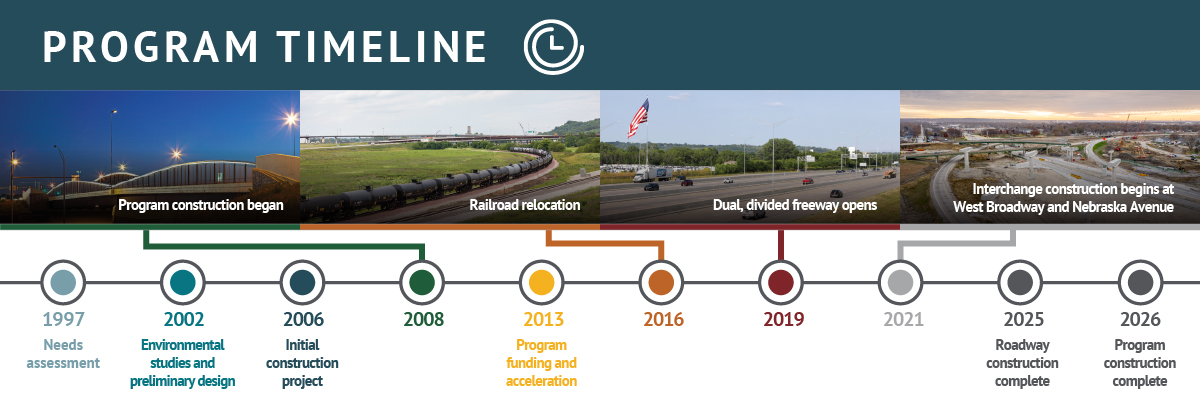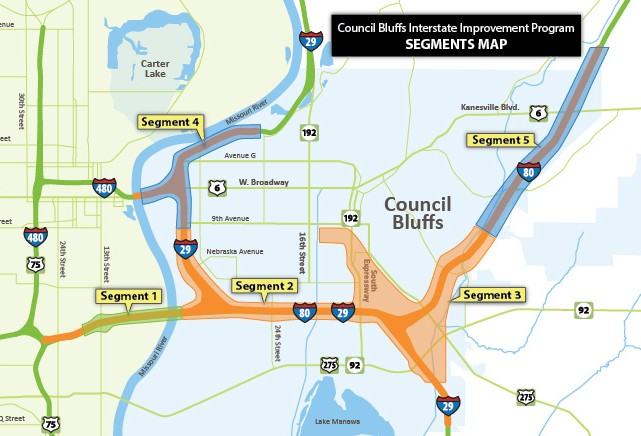Program History

The Council Bluffs Interstate System was constructed in the 1960s and was developed to the design standards of that time. Although routine maintenance projects were completed in the 1980s and 1990s, significant changes had not been made to the Council Bluffs Interstate System since its original construction.
In 1997, the City of Council Bluffs and Metropolitan Area Planning Agency conducted a study of the interstate system in Council Bluffs. The Council Bluffs Interstate System Needs Study, completed in 1999, indicated that many of the interstate’s features were outdated and did not meet today’s design standards, guidelines, or operational criteria. Additionally, the system did not provide adequate travel capacity for future traffic.
In 2002, the Iowa DOT initiated the Council Bluffs Interstate System Improvement Program to address the issues raised by the 1997 Council Bluffs Interstate System Needs Study and developed solutions for improving the interstate system in the Council Bluffs metro area. The program is a multi-year effort that will result in the reconstruction of the majority of the Council Bluffs Interstate System.
In 2006, the Iowa DOT constructed an interim project on the overlapping section of I-80/I-29 to add a third lane in the eastbound direction to ease some of the congestion that occurs when eastbound I-80 and southbound I-29 merge onto one roadway. The interim project was a short-term solution to the congestion problems. A long-term solution is being developed as part of the Program.
Environmental Studies
Solutions for the Council Bluffs Interstate System will balance engineering requirements with environmental constraints and community needs. Federal, state, and local environmental procedures have helped to guide the evaluation of possible solutions identified for the Council Bluffs Interstate System Improvement Program.
The National Environmental Policy Act of 1969 (NEPA) process is being followed in developing the required environmental documentation for the Council Bluffs Interstate Improvement System Program. NEPA is the federal legislation that established a national policy to consider environmental impacts while planning projects using federal funding or requiring federal approvals such as permits. The NEPA process for the Council Bluffs Interstate System Improvement Program is being conducted in two tiers.
Tier 1
The Council Bluffs Interstate System Improvement Program was originally structured to occur in two tiers. Tier 1 focused on the entire interstate system to identify the needs of the system and develop possible solutions (alternatives) to meet those needs. An Environmental Impact Statement was prepared to document the system study. Due to the magnitude of the improvements, the Tier 1 EIS identified five segments of the interstate system for further study in Tier 2. Seven alternatives were identified and reviewed in Tier 1 to determine which alternative could best meet the needs of the interstate system.
- No build – maintain the existing interstate with no significant improvements.
- Improve other metro area roadways – improve other roadways to reduce the amount of traffic on the interstate system.
- Construction of a new cross-town roadway – construct a north bypass on new alignment that would potentially reduce traffic on I-80/I-29.
- Improve alternate modes of transportation – bus improvements, pedestrian/bike improvements that would reduce traffic on the interstate system.
- Transportation Demand Management – reduce demand on the transportation system through alternative work-hour programs, park and ride facilities or van/car pool programs.
- Transportation System Management – better management of the transportation system that improves traffic flow without significant physical improvements.
- Construction Alternative (reconstruct all or part of the interstate) – provide additional capacity, improve access and consolidate or construct new interchanges.
All alternatives were compared, and the Construction Alternative was identified as the preferred alternative in the Tier 1 Draft EIS, which was made available for public and agency review. Comments were considered and used to develop the Tier 1 Final Environmental Impact Statement. The Tier 1 Final Environmental Impact Statement documents the potential impacts of the Construction Alternative. A Record of Decision was prepared to document the decision of selecting the Construction Alternative and also to identify commitments to be addressed during Tier 2. These NEPA documents were made available at the following locations: Council Bluffs Public Library, Omaha Public Library and Iowa DOT District 4 Office.
Tier 2
Tier 2 has focused on completing detailed engineering and environmental studies for segments 1, 2 and 3 of the interstate system. Based on capacity, traffic demand and condition, segments 4 and 5 were deferred for future work. During Tier 2 specific details about project design and property impacts are determined. The status of each of the five segments is outlined below.
- Segment 1– Environmental Assessment
- The Segment 1 Environmental Assessment was approved on October 31, 2006.
- A Finding of No Significant Impact (FONSI) was approved on June 14, 2007.
- Segment 2– Categorical Exclusion
- A Categorical Exclusion was approved on September 9, 2008.
- Segment 3– Environmental Assessment
- The Segment 3 Environmental Assessment was approved on March 14, 2011.
- A Finding of No Significant Impact (FONSI) was approved on August 23, 2011.
- Segment 4– Environmental Assessment
- The Segment 4 Environmental Assessment and 4(f) Findings was approved on July 17, 2017.
- A Finding of No Significant Impact (FONSI) was approved on October 19, 2017.
- Segment 5– Final Environmental Impact Statement
- The Tier 1 Final Environmental Impact Statement evaluated extending I-80 improvements northeast of the Madison Avenue Interchange to east of the U.S. 6/Kanesville Boulevard Interchange. Currently, Segment 5 is reserved for future study in a Tier 2 as warranted by increased traffic demand. No funding or construction has been programmed for this project at this time.






